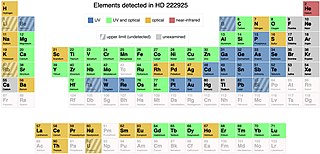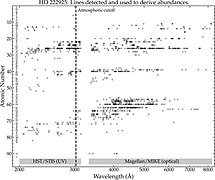 Elements detected in HD 222925 totalling 65 with 42 coming from the r-process (31 ≤ Z ≤ 92) . Elements with no long-lived isotopes are indicated using the light gray font. | |
| Observation data Epoch J2000.00 Equinox J2000.00 | |
|---|---|
| Constellation | Tucana |
| Right ascension | 23 45 17.607 |
| Declination | −61° 54′ 42.84″ |
| Apparent magnitude (V) | 9.03 |
| Characteristics | |
| Evolutionary stage | horizontal branch |
| Spectral type | F8 Sr Eu (ApSrEu) |
| Astrometry | |
| Radial velocity (Rv) | −38.9±0.6 km/s |
| Proper motion (μ) | RA: 143.803 mas/yr Dec.: −99.109 mas/yr |
| Parallax (π) | 2.2202 ± 0.0117 mas |
| Distance | 1,469 ± 8 ly (450 ± 2 pc) |
| Details | |
| Mass | 0.75±0.20 M☉ |
| Radius | 6 R☉ |
| Luminosity | 43 L☉ |
| Surface gravity (log g) | 2.54±0.17 cgs |
| Temperature | 5,636±103 K |
| Metallicity | −1.47±0.08 dex |
| Other designations | |
| CD−62°1462, HD 222925, HIP 117168 | |
| Database references | |
| SIMBAD | data |
HD 222925 is a horizontal branch star about 1,470 light years away in the southern constellation Tucana. It is magnitude 9, far below naked-eye visibility. It is an Ap star, a type of chemically peculiar star with an over-abundance of certain metals in its spectrum.
HD 222925 has been referred to as the 'gold standard star' by the media. In 2022, astronomers from the University of Michigan identified 65 elements in the star (including gold), a turning point to help the scientific community understand the rapid neutron capture process. The elements were produced in a massive supernova or a merger of neutron stars early in the universe, and it was ejected into space where it later reformed into the current star.
Gallery
-
 Wavelength for each element detected by atomic number with each spectral line represented as a dot. A gap between ≈3145 Å and ≈3330 Å reflecting an atmospheric cutoff between STIS and MIKE spectra.
Wavelength for each element detected by atomic number with each spectral line represented as a dot. A gap between ≈3145 Å and ≈3330 Å reflecting an atmospheric cutoff between STIS and MIKE spectra.
-
 This mosaic shows two GHOST spectra of HD 222925.
This mosaic shows two GHOST spectra of HD 222925.
References
- ^ Roederer, Ian U.; Lawler, James E.; Den Hartog, Elizabeth A.; Placco, Vinicius M.; Surman, Rebecca; Beers, Timothy C.; Ezzeddine, Rana; Frebel, Anna; Hansen, Terese T.; Hattori, Kohei; Holmbeck, Erika M.; Sakari, Charli M. (2022). "The R-process Alliance: A Nearly Complete R-process Abundance Template Derived from Ultraviolet Spectroscopy of the R-process-enhanced Metal-poor Star HD 222925". The Astrophysical Journal Supplement Series. 260 (2): 27. arXiv:2205.03426. Bibcode:2022ApJS..260...27R. doi:10.3847/1538-4365/ac5cbc. S2CID 248571656.
- ^ Brown, A. G. A.; et al. (Gaia collaboration) (2021). "Gaia Early Data Release 3: Summary of the contents and survey properties". Astronomy & Astrophysics. 649: A1. arXiv:2012.01533. Bibcode:2021A&A...649A...1G. doi:10.1051/0004-6361/202039657. S2CID 227254300. (Erratum: doi:10.1051/0004-6361/202039657e). Gaia EDR3 record for this source at VizieR.
- Bailer-Jones, C. A. L.; et al. (2011). "Bayesian inference of stellar parameters and interstellar extinction using parallaxes and multiband photometry". Monthly Notices of the Royal Astronomical Society. 411 (1): 435–452. arXiv:1009.2766. Bibcode:2011MNRAS.411..435B. doi:10.1111/j.1365-2966.2010.17699.x. S2CID 30425562.
- ^ Cunha, M. S.; et al. (2019). "Rotation and pulsation in Ap stars: First light results from TESS sectors 1 and 2". Monthly Notices of the Royal Astronomical Society. 487 (3): 3523. arXiv:1906.01111. Bibcode:2019MNRAS.487.3523C. doi:10.1093/mnras/stz1332.
- Houk, Nancy (1975). Michigan catalogue of two-dimensional spectral types for the HD stars. Vol. 1. Ann Arbor, Michigan: Dept. of Astronomy, University of Michigan. Bibcode:1975mcts.book.....H.
- ^ Roederer, Ian U.; Sakari, Charli M.; Placco, Vinicius M.; Beers, Timothy C.; Ezzeddine, Rana; Frebel, Anna; Hansen, Terese T. (2018). "The R-Process Alliance: A Comprehensive Abundance Analysis of HD 222925, a Metal-poor Star with an Extreme R-process Enhancement of [Eu/H] = -0.14". The Astrophysical Journal. 865 (2): 129. arXiv:1808.09469. Bibcode:2018ApJ...865..129R. doi:10.3847/1538-4357/aadd92. S2CID 119046070.
- Cruzalèbes, P.; Petrov, R. G.; Robbe-Dubois, S.; Varga, J.; Burtscher, L.; Allouche, F.; Berio, P.; Hofmann, K. H.; Hron, J.; Jaffe, W.; Lagarde, S.; Lopez, B.; Matter, A.; Meilland, A.; Meisenheimer, K.; Millour, F.; Schertl, D. (2019). "A catalogue of stellar diameters and fluxes for mid-infrared interferometry". Monthly Notices of the Royal Astronomical Society. 490 (3): 3158–3176. arXiv:1910.00542. Bibcode:2019MNRAS.490.3158C. doi:10.1093/mnras/stz2803. S2CID 203610229.
- "Astronomers find 'gold standard' star in Milky Way". University of Michigan News. 2022-05-10. Retrieved 2022-05-18.
- Sherburne, Morgan; Michigan, University of. "Astronomers find 'gold standard' star in Milky Way". phys.org. Retrieved 2022-05-18.
- Science, Carnegie (2022-05-13). "Astronomers find 'gold standard' star in Milky Way". Carnegie Institution for Science. Archived from the original on 2022-05-13. Retrieved 2022-05-18.
- "Gemini's GHOST Captures Exquisite First Light Observations of a Bright, Chemically Rich Star". Retrieved 16 December 2022.
External links
- Hensley, Kerry (2023-07-26). "Making Sense of the Many Metals in HD 222925's Spectrum". AAS Nova.
| Constellation of Tucana | |||||||||||
|---|---|---|---|---|---|---|---|---|---|---|---|
| Stars |
| ||||||||||
| |||||||||||
| Star clusters |
| ||||||||||
| |||||||||||
| Galaxies |
| ||||||||||